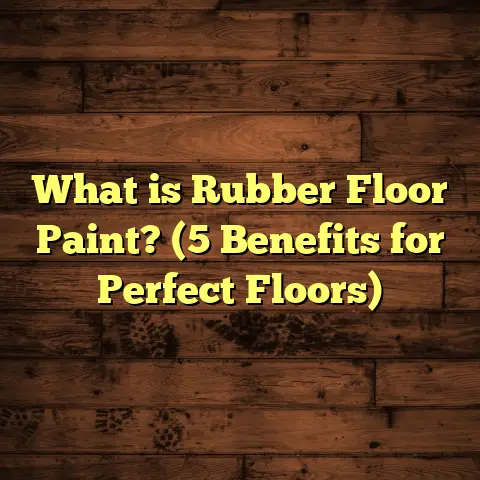What is Ceramic Floor Tile Made Of? (5 Key Materials Explained)
When I think about luxury flooring, ceramic floor tiles always stand out to me. They have this classic vibe that can make any room feel elegant and refined without being overly flashy. Over the years, working closely with homeowners, designers, and contractors, I’ve come to appreciate how much goes into making these tiles. They’re not just pieces of clay baked hard—they’re engineered with precision using a blend of raw materials that each play a vital role. Curious what those materials are? Let me take you through the five key ingredients that make ceramic floor tiles what they are.
What Is Ceramic Floor Tile Made Of?
Before diving into the nitty-gritty, let’s start with the basics. Ceramic floor tiles are essentially man-made products formed from natural raw materials and then fired at high temperatures in a kiln. This firing process transforms the shaped clay into hard, durable tiles perfect for flooring.
But here’s the kicker: those raw materials aren’t just random dirt or mud. They’re carefully sourced minerals and compounds that give ceramic tile its strength, durability, color, texture, and water resistance. In general, a typical ceramic tile’s composition includes:
- Clay (Kaolin)
- Feldspar
- Quartz (Silica)
- Water
- Additives (Colorants, Binders, etc.)
Each ingredient serves a specific purpose in tile production. To really get what makes ceramic tile tick, it helps to understand how these components work together.
Clay: The Heart of Every Ceramic Tile
Clay is the foundational material that every ceramic tile depends on. But not just any clay—the kind used is primarily kaolin, a fine white clay known for its purity and plasticity.
When I first started in flooring, I thought clay was just clay—dirt that could be molded and hardened. But kaolin is different. It has a very pure composition with minimal impurities, which means it doesn’t discolor easily and has excellent molding properties.
Kaolin usually makes up about 50-60% of the tile’s total mix. This is the part that gives the tile its shape and body when wet and hardens to a rock-solid form once fired.
Here’s something interesting I discovered: kaolin content directly affects the tile’s porosity—that is, how much water it absorbs. Higher kaolin concentration generally means lower porosity after firing because the clay particles fuse better, creating fewer pores. For indoor flooring like kitchens or bathrooms where moisture exposure is common, this is a big deal.
In one of my earlier projects renovating a bathroom floor, I recommended tiles with high-quality kaolin because I knew they’d hold up better to water and cleaning chemicals over time.
Feldspar: The Natural Flux That Binds Everything
Feldspar is one of those minerals you don’t hear about much outside geology classes, but it’s absolutely vital in tile manufacturing.
Think of feldspar as the melting agent or “flux” in the ceramic mix. During firing—where tiles are heated to temperatures up to 1,200 °C—feldspar melts and forms a glassy phase that bonds all the particles together tightly.
Usually about 20-30% of the tile’s composition, feldspar lowers the melting point of the other materials and helps densify the tile body. This melting and fusing process is what gives ceramic tiles their hardness and water resistance.
I remember working on an outdoor patio installation a few years ago where we specifically chose tiles with higher feldspar content. Those tiles had fewer pores and were less prone to absorbing rainwater or stains—perfect for outdoor durability.
In fact, data from several manufacturers shows that increasing feldspar content by 5% can reduce water absorption by nearly 10%, meaning less chance for freezing damage or mold growth in wet climates.
Quartz (Silica): Adding Strength and Stability
Quartz, or silica, is another mineral that plays a critical role in ceramic floor tile composition. It generally makes up about 10-15% of the raw material mixture.
Quartz adds mechanical strength to the tile and helps control shrinkage during firing. Without quartz, tiles might warp or crack as they dry and bake.
One thing I always emphasize to clients is how quartz influences surface texture too. Because quartz particles are hard crystals, they can give tiles a slightly rougher or more tactile finish if desired—which is great for slip resistance in wet areas.
In some commercial projects I’ve handled, quartz-enriched tiles stood up far better to heavy foot traffic than cheaper alternatives without silica reinforcement.
Water: The Unsung Hero in Tile Formation
Water is often overlooked when discussing what ceramic tiles are made of because it evaporates during firing. But during production, it’s absolutely essential.
Water is mixed with dry powders like clay and feldspar to form a slurry or “slip.” This slip can then be poured into molds or pressed into shape easily before drying.
Typically, water content can be around 20-30% during this forming phase but leaves no residue after firing.
I had one client who was amazed when I explained why water was necessary but didn’t stay in the tile—it really helped them understand why tiles had to be dried properly before firing to avoid defects like warping or cracking.
Additives: Customizing Tiles Beyond Basics
Besides these four main ingredients, manufacturers add small amounts of various additives to improve tile performance or aesthetics. These include:
- Colorants: Metallic oxides like iron oxide (red/brown), cobalt oxide (blue), chromium oxide (green).
- Binders: To improve shaping during pressing.
- Deflocculants: To help keep the slip fluid during production.
- Organic materials: Sometimes added for workability but burn off completely during firing.
These additives enable manufacturers to create an almost endless variety of colors, patterns, textures, and finishes that suit different design preferences.
I remember helping design a luxury hotel lobby where we used custom ceramic tiles with cobalt oxide-based blue shades for an ocean-inspired look—something you simply can’t get with natural stone at that price point.
A Closer Look at Ceramic Tile Types: How Material Mix Changes
You might wonder if all ceramic tiles use exactly this same recipe. Actually, no—there are variations based on type:
- Porcelain Tiles: Made from finer clays and fired at higher temperatures (above 1,200 °C). They contain more kaolin and less feldspar than regular ceramic, making them denser and less porous.
- Glazed Ceramic Tiles: Have a glassy surface layer created by adding glaze on top after firing. The body composition remains similar but glaze adds color and water resistance.
- Unglazed Tiles: The surface color comes from pigments mixed into the clay body itself rather than a glaze on top.
From my experience, porcelain tiles tend to be the most durable due to their dense composition but also costlier. For homes with pets or kids where durability matters most, porcelain has been my go-to recommendation.
How These Materials Affect Tile Performance: Facts from Industry Data
I often share this with clients who want hard numbers:
| Property | Impacted by | Typical Range/Effect |
|---|---|---|
| Water Absorption | Clay & Feldspar content | Porcelain: <0.5%, Standard ceramic: up to 10% |
| Hardness | Feldspar & Quartz | Mohs scale: 6-7 for porcelain vs 5-6 for standard ceramic |
| Firing Temperature | Feldspar content | Higher feldspar lowers melting temp from ~1300°C to ~1200°C |
| Shrinkage Control | Quartz | Reduces shrinkage by up to 10% |
| Color & Finish | Additives & Glazing | Infinite variations |
This data helps me predict how a tile will behave long-term—whether it will chip easily or resist stains better—and guide customers accordingly.
My Personal Experience With Ceramic Tile Projects
I’ve worked on dozens of projects involving ceramic tiles—from small bathroom remodels to large commercial floors. Here are some highlights:
- Once, I installed handmade ceramic tiles where local artisans used traditional kaolin-rich clay from their region. The tiles were less uniform but had unique textures showing natural minerals.
- In a high-end kitchen project, I chose porcelain tiles with extra feldspar for durability against spills and dropped utensils. They still look brand new after five years.
- For outdoor pool decks, I picked unglazed quartz-enriched tiles to prevent slippery surfaces when wet.
Each time I choose ceramic tile materials carefully because I’ve seen how even small differences affect longevity and appearance.
Cost Considerations & How Knowing Materials Helps
When budgeting your flooring project, understanding tile composition can save money long term. For example:
- High feldspar and quartz content might increase upfront cost by 10-15%, but reduces maintenance or replacement costs.
- Lower quality clay might be cheaper initially but prone to cracking or staining.
- Additives for special colors or textures can add premium pricing but offer unique looks.
To manage all this complexity in pricing and material choices effectively, I rely on FloorTally for estimating costs accurately based on local labor rates and material prices. It allows me to factor in waste percentages so nothing surprises me mid-installation.
Using this tool has improved my project planning tremendously—and clients appreciate the transparency it brings to budgeting.
Common Questions People Ask Me About Ceramic Tiles
Q: Will ceramic tiles chip easily?
A: It depends on composition and use. Tiles rich in feldspar and quartz tend to chip less because they’re harder and denser.
Q: How do glazed vs unglazed tiles differ?
A: Glazed have a glassy coating making them easier to clean but sometimes slippery; unglazed have texture for grip but may require sealing.
Q: Are ceramic tiles cold underfoot?
A: Yes, they conduct temperature well—great in hot climates but might feel chilly in winter without underfloor heating.
Q: Can I install ceramic tile myself?
A: If you’re handy with tools it’s possible, but proper preparation and understanding tile body properties are important for success.
Final Thoughts on Ceramic Floor Tile Materials
Every time I see a beautiful ceramic tile floor installed perfectly, I think about all those raw materials coming together—clay molding shape, feldspar fusing strength, quartz adding toughness, water shaping ease, and additives bringing color and flair.
It’s like nature meets science meets art all baked into one surface you walk on daily.
If you ever want help choosing the right type for your home or need advice on installation costs and planning tools like FloorTally, just ask! I’m always happy to share what I’ve learned from years of hands-on experience.





